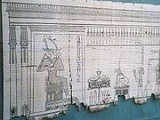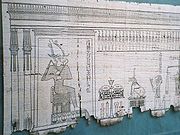
Duat
Encyclopedia

Egyptian mythology
Ancient Egyptian religion was a complex system of polytheistic beliefs and rituals which were an integral part of ancient Egyptian society. It centered on the Egyptians' interaction with a multitude of deities who were believed to be present in, and in control of, the forces and elements of nature...
, Duat (also Tuat and Tuaut) (also called Akert, Amenthes, or Neter-khertet) is the underworld
Underworld
The Underworld is a region which is thought to be under the surface of the earth in some religions and in mythologies. It could be a place where the souls of the recently departed go, and in some traditions it is identified with Hell or the realm of death...
. The Duat is a vast area under the Earth, connected with Nun, the waters of the primordial abyss. The Duat is the realm of the god Osiris
Osiris
Osiris is an Egyptian god, usually identified as the god of the afterlife, the underworld and the dead. He is classically depicted as a green-skinned man with a pharaoh's beard, partially mummy-wrapped at the legs, wearing a distinctive crown with two large ostrich feathers at either side, and...
and the residence of other gods and supernatural beings. It is the region through which the sun god Ra
Ra
Ra is the ancient Egyptian sun god. By the Fifth Dynasty he had become a major deity in ancient Egyptian religion, identified primarily with the mid-day sun...
travels from west to east during the night, and where he battled Apep
Apep
In Egyptian mythology, Apep was an evil god, the deification of darkness and chaos , and thus opponent of light and Ma'at , whose existence was believed from the 8th Dynasty onwards...
. It also was the place where people's souls went after death for judgement, though it was not the full extent of the afterlife. Burial chambers formed touching-points between the mundane world and the Duat, and spirits could use tombs to travel back and forth from the Duat.
What we know of the Duat principally derives from funerary texts such as Book of Gates
Book of Gates
The Book of Gates is an Ancient Egyptian funerary text dating from the New Kingdom. It narrates the passage of a newly deceased soul into the next world, corresponding to the journey of the sun though the underworld during the hours of the night. The soul is required to pass though a series of...
, Book of Caverns
Book of Caverns
The Book of Caverns is an important Ancient Egyptian funerary text of the New Kingdom. Like many funerary texts, it was written on the inside of the tomb for reference by the deceased...
, Coffin Texts
Coffin Texts
The Coffin Texts are a collection of ancient Egyptian funerary spells written on coffins beginning in the First Intermediate Period. The texts are derived in part from the earlier pyramid texts, reserved for royal use only, but they contain substantial new material related to everyday desires that...
, Amduat
Amduat
The Amduat is an important Ancient Egyptian funerary text of the New Kingdom. Like many funerary texts, it was found written on the inside of the pharaoh's tomb for reference...
and the Book of the Dead
Book of the Dead
The Book of the Dead is the modern name of an ancient Egyptian funerary text, used from the beginning of the New Kingdom to around 50 BC. The original Egyptian name for the text, transliterated rw nw prt m hrw is translated as "Book of Coming Forth by Day". Another translation would be "Book of...
. Each of these documents fulfills a different purpose and gives a different perspective on the Duat, and different texts can be inconsistent with one another. The texts which survive differ in age and origin, and it is likely that there was never a single uniform interpretation of the Duat.
The geography of Duat is similar in outline to the world the Egyptians knew. There are realistic features like rivers, islands, fields, lakes, mounds and caverns, along with fantastic lakes of fire, walls of iron and trees of turquoise. In the Book of Two Ways, one of the Coffin Texts
Coffin Texts
The Coffin Texts are a collection of ancient Egyptian funerary spells written on coffins beginning in the First Intermediate Period. The texts are derived in part from the earlier pyramid texts, reserved for royal use only, but they contain substantial new material related to everyday desires that...
, there is even a map-like image of the Duat.
The Book of the Dead
Book of the Dead
The Book of the Dead is the modern name of an ancient Egyptian funerary text, used from the beginning of the New Kingdom to around 50 BC. The original Egyptian name for the text, transliterated rw nw prt m hrw is translated as "Book of Coming Forth by Day". Another translation would be "Book of...
and Coffin Texts
Coffin Texts
The Coffin Texts are a collection of ancient Egyptian funerary spells written on coffins beginning in the First Intermediate Period. The texts are derived in part from the earlier pyramid texts, reserved for royal use only, but they contain substantial new material related to everyday desires that...
were intended to guide the recently deceased through the Duats dangerous landscape and to a life as an akh or blessed spirit amongst the gods. The dead person must pass a series of gates guarded dangerous spirits, depicted as human bodies with grotesque heads of animals, insects, torches or knives. These beings have equally grotesque names, for instance "Blood-drinker who comes from the Slaughterhouse" or "One who eats the excrement of his hindquarters". Other features emphasised in these texts are mounds and caverns, inhabited by gods or supernatural animals, which threatened the spirits of the dead. The purpose of the books is not to lay out a geography, but to describe a succession of rites of passage which the dead would have to pass to reach the afterlife.
If the deceased successfully passed these unpleasant demons, he or she would reach the Weighing of the Heart. In this ritual, the heart of the deceased was weighed by Anubis
Anubis
Anubis is the Greek name for a jackal-headed god associated with mummification and the afterlife in ancient Egyptian religion. In the ancient Egyptian language, Anubis is known as Inpu . According to the Akkadian transcription in the Amarna letters, Anubis' name was vocalized as Anapa...
, using a feather, representing Ma'at, the goddess of truth and justice. The heart would become out of balance because of failure to follow Ma'at and any hearts heavier or lighter than her feather were rejected and eaten by the Ammit
Ammit
thumb|right|400px|This detail scene from the [[Papyrus]] of [[Hunefer]] shows [[Hunefer]]'s heart being weighed on the scale of [[Maat]] against the [[feather of truth]], by the [[jackal]]-headed [[Anubis]]. The [[Ibis]]-headed [[Thoth]], [[scribe]] of the [[gods]], records the result...
, the Devourer of Souls. Those souls that passed the test would be allowed to travel toward the paradise
Paradise
Paradise is a place in which existence is positive, harmonious and timeless. It is conceptually a counter-image of the miseries of human civilization, and in paradise there is only peace, prosperity, and happiness. Paradise is a place of contentment, but it is not necessarily a land of luxury and...
of Aaru
Aaru
In ancient Egyptian mythology, the fields of Aaru or the Egyptian reed fields, are the heavenly paradise, where Osiris ruled after he became part of the Egyptian pantheon and displaced Anubis in the Ogdoad tradition...
.
In spite of the unpleasant inhabitants of the Duat, this was no Hell to which souls were condemned; the nature of Duat is more complex than that. The grotesque spirits of the underworld were not evil, but under the control of the Gods. The Duat was also a residence of gods themselves; as well as Osiris, Anubis
Anubis
Anubis is the Greek name for a jackal-headed god associated with mummification and the afterlife in ancient Egyptian religion. In the ancient Egyptian language, Anubis is known as Inpu . According to the Akkadian transcription in the Amarna letters, Anubis' name was vocalized as Anapa...
, Thoth
Thoth
Thoth was considered one of the more important deities of the Egyptian pantheon. In art, he was often depicted as a man with the head of an ibis or a baboon, animals sacred to him. His feminine counterpart was Seshat...
, Horus
Horus
Horus is one of the oldest and most significant deities in the Ancient Egyptian religion, who was worshipped from at least the late Predynastic period through to Greco-Roman times. Different forms of Horus are recorded in history and these are treated as distinct gods by Egyptologists...
, Hathor
Hathor
Hathor , is an Ancient Egyptian goddess who personified the principles of love, beauty, music, motherhood and joy. She was one of the most important and popular deities throughout the history of Ancient Egypt...
and Ma'at all appear as a dead soul makes its way toward judgement. It was also in the underworld that the sun, Ra
Ra
Ra is the ancient Egyptian sun god. By the Fifth Dynasty he had become a major deity in ancient Egyptian religion, identified primarily with the mid-day sun...
, travelled under the Earth from west to east and was transformed from its aged Atum
Atum
Atum, sometimes rendered as Atem or Tem, is an important deity in Egyptian mythology.- Name :Atum's name is thought to be derived from the word 'tem' which means to complete or finish. Thus he has been interpreted as being the 'complete one' and also the finisher of the world, which he returns to...
form into Khepri
Khepri
This article is about the Egyptian god. For the type of robot, see Khepera mobile robot.In Egyptian mythology, Khepri is the name of a major god. Khepri is associated with the dung beetle , whose behavior of maintaining spherical balls of dung represents the forces which move the sun...
, the new dawning Sun. Just as a dead person faced many challenges in the Duat, Ra faced attack in the underworld from the evil serpent Apep
Apep
In Egyptian mythology, Apep was an evil god, the deification of darkness and chaos , and thus opponent of light and Ma'at , whose existence was believed from the 8th Dynasty onwards...
.

